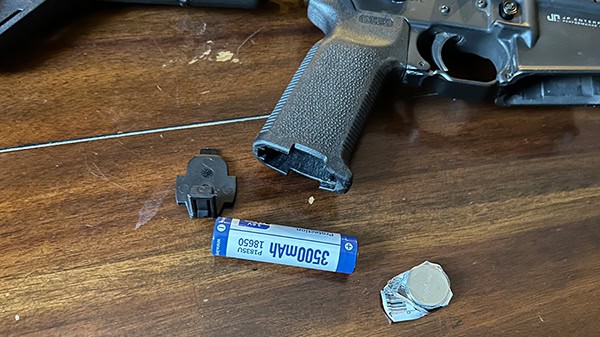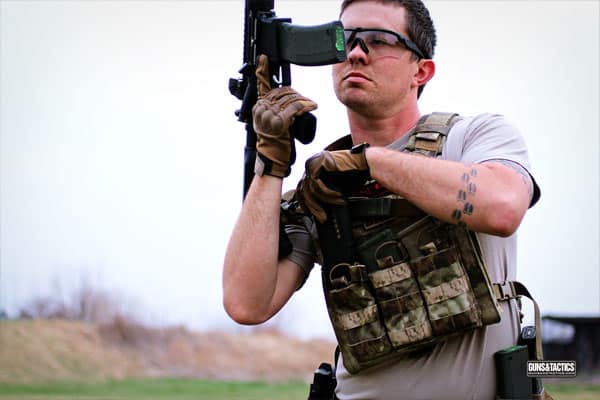TAG Precision—American-made RMR Plate for Kimber
For users of optics-ready Kimber 1911 and 2K11 pistols, TAG Precision has announced…
For users of optics-ready Kimber 1911 and 2K11 pistols, TAG Precision has announced…
Fountain Valley, CA—SureFire, LLC, manufacturer of the world’s finest—and most innovative—illumination tools and…
Shinenyx—creators of a cutting-edge fusion of digital night vision and thermal imaging technology—has…
All shooting is a balance between speed and precision. By that I mean you can…
The Mod-Navy Qual I’ve been doing this qual (or drill, or whatever the current nom…
• Built for road trips and off-road use• Manual transmission equipped• Wrapped in MultiCam Arctic…
Every week we see an article about the TSA and x-ray machines at airports. In recent international travels I decided to do my best and avoid becoming a victim of Transportation Security Administration (TSA) criticism, while trying not to compromise my personal safety tool kit.
Over the years, I’ve learned a few tricks to help me breeze through the airport security checkpoints. Having recently applied these tactics while traveling to Washington D.C., Vienna, Munich and Moscow, I figure it’s time to share some tactical tips and tricks with Guns & Tactics readers.
I always wait until the last minute to pack so I’ve applied a “safety inspection” step to my routine as a result. When I pack my clothes I always turn the pockets inside out and dust them off, this ensures I have nothing interesting for TSA to suspect in my pockets. No money, no jewelry, no ammo, you get the idea.
Next, I do the same thing to my suitcase and carry-on luggage. I make sure all the default items are accounted for in the carry-on: airplane headphone with adapter, cell phones, laptop cables, travel pillow, power converter for Europe, etc.
Most importantly, I make sure that my Surefire E2E tactical flashlight and my Embassy Pen are located in the front zipper compartment. My intent is to make it obvious to TSA that I know it is here, and to keep it readily accessible to me anytime I am pulling my carry-on, but without wearing it on my body. In the past three-years I’ve not been questioned about my flashlight or my tactical pen being in the carry-on.
I like to be comfortable on the plane, so I wear a casual set of clothes with a nice shirt. I pack an extra t-shirt in the carry-on in case something spills on what I’m wearing. This has proven to be a good habit for me in general but the one thing I do differently on fly day is to wear a Velcro under-belt.
This belt will pass directly through security detectors without triggering the alarm and it saves me time that would have been used up removing my belt for TSA inspection. When they ask me to remove it, I tell them there is no metal on it and they waive me into the scanner. No bells or whistles and I come out sailing with a smile each time.
Before passing through the security scanner I make sure that my laptops, bucket of shoes, and carry-on have all made it safely into the machine.
Have your passport ready with your visa and boarding pass. To keep it secure and ready to present if necessary, have it out of your pockets and in your hand as you approach the controlled access areas.
For those times when I’m packing a checked piece of luggage, I place a small folding Blade-Tech pocketknife within the luggage, usually in an interior zipping pouch. This way, I’ll have my pocketknife available upon arrival at my destination.
For the best perks of the tactical travel experience, you’ll want to take advantage of any business class or card holder programs that give you access to the lounge. Here you’ll be able to take a shower, change clothes, get some food and rehydrate on water and booze all of which is basically free to those with access. However, sometimes you can buy a pass at the service desk depending upon how busy the lounge is. I’ve paid anywhere from $25 to $40 for a day-pass. I’ve also purchased them in advance on craigslist.
Another trick I’ve adopted is to request exit row seats. This usually gives me a bit more leg room at no extra cost, although some airlines are now charging for it. If I fly coach, the exit row request usually works out for me. As a personal preference, it’s comforting to sit near the exit, too.
Finally, if you want to sleep on the plane, you can drift into dreamland knowing that the people stuck in the tube with you can’t go anywhere either. You have friendly flight attendants watching out for your safety, so it’s probably okay to get some much needed rest at 30,000 feet if you need to.
Got more tips and tricks for us? Share them with a comment!
Guns & Tactics is an online media outlet that focuses on the firearms community, not just firearms and gear but also quality training, technical break downs and enlightening presentations.
When I first got on with my department I was about two thousand dollars deep in gear, uniform parts, and every cool whizbang doodad that I was told…
[dcs_img_center desc=”Photo Credit: Chris Tran” framed=”black” w=”600″ h=”400″] http://gunsandtactics.wpengine.com/wp-content/uploads/2016/11/TRAN_Arisaka-0249.jpg [/dcs_img_center] [dcs_post_top] [dcs_fancy_header bgcolor=”#ffffff” color=”#000000″ fweight=”bold”]Innovative accessories for the AR market[/dcs_fancy_header] [dcs_thinspliter size=”medium”] Several months ago, I was introduced…

In this quick tip video we go over how to properly store items you might really need in your AR15 grip. Keeping it dry and rattle free.
NFA Executive Order Blocked By US House The Chief Law Enforcement Officer (CLEO) requirement for the National Firearms Act (NFA) has been a requirement since the NFA was…
I am sure every adult who has ever fired a gun, can recall the first time they pressed the trigger, felt the recoil and observed the impact. Some…

A new lightweight rifle plate and carrier combo by DKX Armor and CSE Gear. Call me paranoid but I refuse to attend classes or training and not wear…
© 2025 UN12 Magazine
© 2025 UN12 Magazine
Wait! Don’t forget to